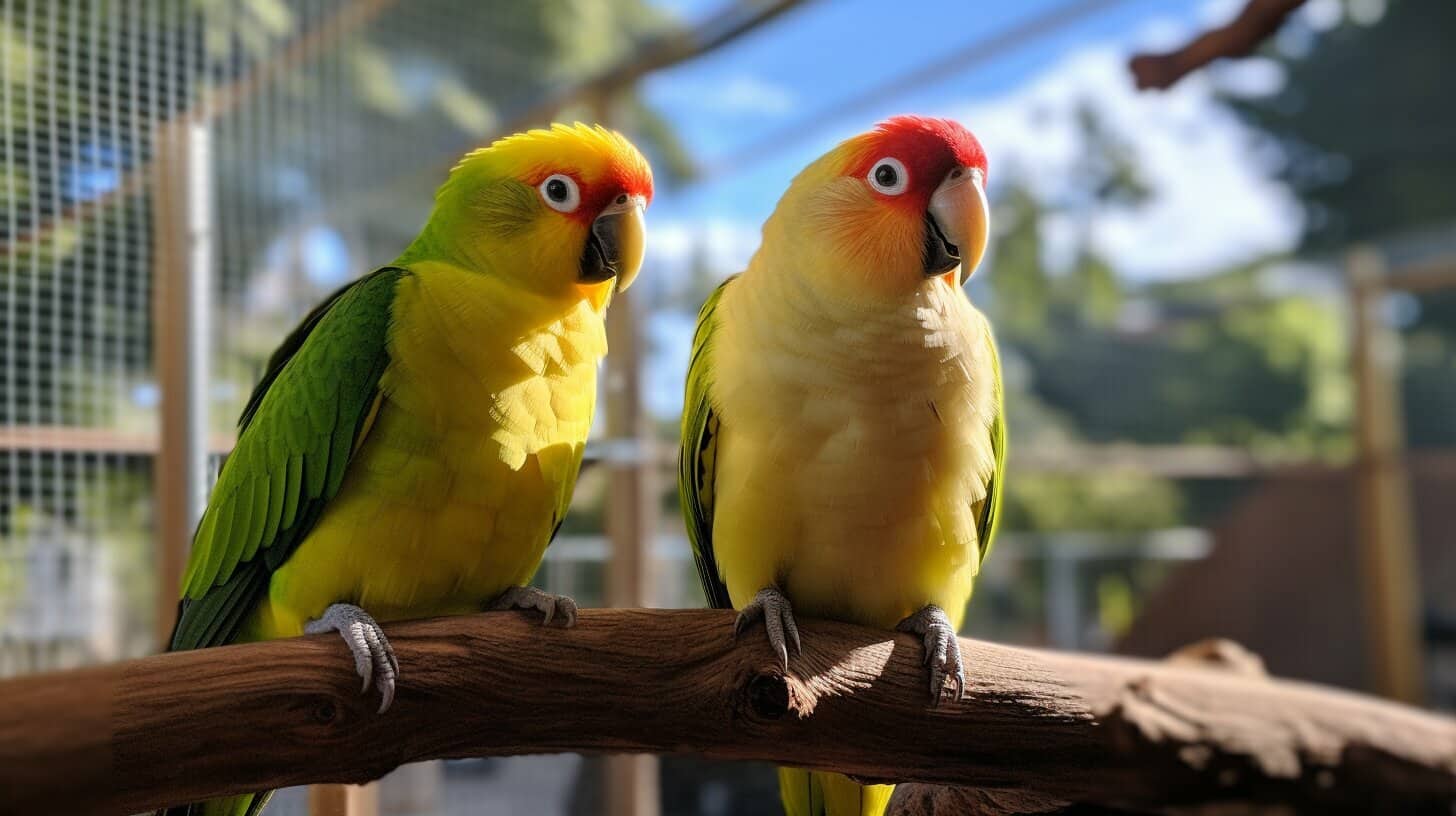A common pastime that many people around the world enjoy is keeping birds as pets. While some choose to keep a single species, others house multiple types of birds together in the same aviary. Among them, Kakariki and Budgies are two of the most popular species kept as pets. However, before attempting to keep them together, it’s essential to consider their compatibility and ensure that a harmonious environment can be created for both species.
In this article, we will explore whether or not Kakarikis and Budgies can live together peacefully in the same aviary. We will discuss the compatibility between these two bird species and provide insights into creating a harmonious environment for them. We will also cover practical topics such as housing, introducing, caring for, and socialising Kakarikis and Budgies to ensure their well-being.
Can Kakarikis and Budgies Live Together? Kakarikis and budgies can potentially cohabitate but with caution. Both species have distinct temperaments and care requirements. While they might tolerate one another under ideal conditions, harmony’s not guaranteed. For their well-being, ensure they have enough space, separate feeding zones, and closely monitor their interactions. Any sign of aggression or stress indicates that cohabitation might not be ideal.
Key Takeaways
- Kakariki and Budgies can potentially live together in the same aviary if the proper precautions are taken.
- Creating a harmonious environment for both species requires careful planning and consideration.
- Topics such as housing, introducing, caring, and socializing are crucial in ensuring the well-being of both Kakariki and Budgies.
Housing Kakariki and Budgies Together
When housing Kakarikis and Budgies, it is important to ensure that the aviary can comfortably accommodate both species. A good rule of thumb is to have at least 3 square meters of floor space for every four birds. The aviary should also have perches of varying sizes and textures to cater to the different needs of each species.
Providing nesting boxes for Kakarikis and Budgies is recommended, as they require space to call their own. The boxes should be placed at opposite ends of the aviary to prevent clashes between the birds. Providing ample food and water bowls to prevent competition and ensure both species have access to resources is also important.
Perches for Kakariki and Budgies
Kakarikis are known for their love of climbing and playing, requiring sturdy perches that can withstand their active behaviour. On the other hand, Budgies prefer smaller and softer perches to rest and sleep on. Providing perches of different sizes and textures can help cater to the needs of both species and prevent aggression.
Nesting Boxes for Kakariki and Budgies
Kakariki and Budgies have different nesting requirements, and it is important to provide appropriate nesting boxes that cater to their individual needs. Kakarikis prefers larger wood or bark nesting boxes, while Budgies prefer smaller boxes of wire or plastic. By providing nesting boxes that cater to the needs of both species, you can prevent territorial disputes and promote a harmonious coexistence.
Introducing Kakariki and Budgies
Introducing Kakariki and Budgies requires gradually reducing the risk of aggression and stress. Both species may be territorial, and sudden introductions can lead to fights and injuries.
Keeping the new birds separated for the first few days is essential, allowing them to adjust to their new surroundings. During this period, you can keep them in separate cages or use a divider to create a separate partition in the aviary.
You may introduce the birds in their cages, allowing them to observe each other from a distance. This helps them get used to each other’s presence. Once they seem more accustomed, you may allow them to interact under close supervision.
Monitoring the birds’ behaviour and body language during the introduction process is crucial. If you notice any signs of aggression, such as fluffing up feathers, lunging, or biting, you may need to separate them for a while and start the process again.
Another crucial aspect of introducing Kakariki and Budgies is to provide ample resources such as food, water, and perches. This ensures that neither species feels deprived, reducing the chances of competition and aggression.
It is also essential to stay patient and give the birds enough time to adapt to their new environment and each other. With proper care and patience, Kakariki and Budgies can learn to cohabit harmoniously in the same aviary.
Caring for Kakariki and Budgies
Proper care and maintenance are essential for the health and well-being of both Kakariki and Budgies when living together. Here are some tips and guidelines to follow:
Diet
Ensure both species access a balanced, varied diet of seeds, pellets, fruits, and vegetables. Avoid feeding them avocado, chocolate, caffeine, alcohol, and sugary or salty foods, as these can be toxic or harmful to their health.
Grooming
Maintain good hygiene in the aviary by providing a clean environment and regular baths or misting. Trim their wings and nails as needed, and check for signs of illness or injury, such as feather loss or abnormal behaviour.
Enrichment
Provide toys, perches, and other forms of enrichment to keep both species mentally and physically stimulated. This can include foraging toys, swings, ladders, and mirrors. Rotate the toys and rearrange the perches regularly to prevent boredom and promote exploration.
Health check-ups
Regularly monitor the health of both Kakarikis and Budgies and promptly seek veterinary care if any issues arise. Schedule yearly check-ups and vaccinations to prevent and detect illnesses or diseases.
Interaction
Interact with both species regularly to maintain their socialization and prevent boredom. This can include talking to them, offering treats, and spending time near the aviary. Avoid handling them too frequently or harshly, which can cause stress and injury.
By following these guidelines, you can ensure that both Kakariki and Budgies receive the care they need to thrive when living together.
Socializing Kakarikis and Budgies
Keeping Kakariki and Budgies together can benefit their mental and emotional well-being. As social creatures, both species thrive on socializing and interacting with others. However, introducing them to each other requires careful planning and monitoring to ensure a harmonious coexistence.
When socializing Kakariki and Budgies, it’s important to understand their natural behaviours and flock dynamics. Kakariki is generally more outgoing and adventurous, while Budgies are more reserved and cautious. Creating different areas within the aviary that cater to the needs of both species can encourage positive social interactions.
Offering a variety of perches at different heights and levels can also provide opportunities for the birds to socialize. Kakariki are excellent climbers and enjoy exploring their environment, while Budgies prefer to stay closer to the ground. Providing toys and objects they can play with can also create a stimulating environment for both species.
As with any socializing process, monitoring the birds’ behaviour is critical. Signs of aggression or stress should not be ignored, and it may be necessary to separate them if one or both birds seem uncomfortable. Gradual introduction, cages or barriers, and close monitoring can help minimize potential conflicts and ensure a happy, harmonious aviary.
Cohabitating Kakarikis and Budgies: Tips for Success
Keeping Kakariki and Budgies together can be a rewarding experience for both bird species and their owners. The following tips will help you create a harmonious environment and ensure the well-being of both species:
| Tips | Description |
|---|---|
| Provide ample space | Give both species enough room to fly and move around comfortably. The aviary should be at least 3 meters long and 1.5 meters wide for a small group of birds. |
| Create different areas | Designate separate areas within the aviary for feeding, drinking, and nesting. This will help avoid competition and reduce the risk of aggression. |
| Offer a balanced diet | Make sure both species have access to a varied and healthy diet. Supply fresh fruits, vegetables, and high-quality bird seed and pellets. Consult a veterinarian or avian nutritionist for specific recommendations. |
| Monitor behaviour | Ensure both species have enough resources, such as perches, toys, and nesting boxes. This will help prevent competition and promote a stress-free environment. |
| Provide ample resources | Make sure both species have enough resources, such as perches, toys, and nesting boxes. This will help prevent competition and promote a stress-free environment. |
| Keep the aviary clean | Clean the aviary regularly and replace the bedding or substrate as needed. This will help prevent the spread of disease and keep the birds healthy. |
To ensure the success of cohabitating Kakariki and Budgies, it is important to take the necessary steps to create a healthy and safe environment for both bird species. By following these tips and being vigilant in monitoring their behaviour and well-being, you can create a harmonious aviary that will be a joy to observe and care for.
Conclusion
Keeping Kakariki and Budgies together can be a rewarding experience for bird enthusiasts. However, it requires careful planning, attention to detail, and ongoing monitoring to ensure the well-being of both species.
As we have discussed, creating a harmonious environment for these birds involves providing ample space, resources, and opportunities for socialization. Introducing them slowly and methodically, and paying attention to their behaviour during the initial stages, is crucial to their success in cohabiting.
General care and maintenance, including a balanced diet, grooming, and health check-ups, are essential for the long-term health of both species. Socialization is also important for their mental and emotional well-being.
Tip:
Regularly monitor for signs of stress or aggression and take appropriate steps to address any issues that may arise. This may involve creating separate areas within the aviary or adjusting the environment to cater to the individual needs of each species.
Following these tips and taking a proactive approach to cohabitating Kakarikis and Budgies, you can enjoy a thriving and harmonious aviary.
FAQ
Q: Can Kakarikis and Budgies live together?
A: Yes, Kakariki and Budgies can live together peacefully in the same aviary if the necessary steps are taken to ensure their compatibility and well-being.
Q: What are the housing requirements for cohabitating Kakarikis and Budgies?
A: When housing Kakariki and Budgies together, it is important to provide an aviary of sufficient size, with ample perches and nesting boxes to accommodate both species comfortably.
Q: How should Kakarikis and Budgies be introduced to each other?
A: It is crucial to gradually introduce Kakariki and Budgies to each other, using cages or barriers to prevent direct contact. Monitoring their behaviour during this process is essential.
Q: What care and maintenance do Kakariki and Budgies require when living together?
A: Both Kakariki and Budgies need a well-balanced diet, regular grooming, enrichment activities, and periodic health check-ups to ensure their overall well-being in a shared living environment.
Q: How can social interactions be encouraged between Kakariki and Budgies?
A: Understanding their natural behaviours and flock dynamics is important in promoting positive social interactions between Kakariki and Budgies. Providing opportunities for socializing is beneficial for their mental and emotional well-being.
Q: What tips can help in successfully cohabitating Kakariki and Budgies?
A: Maintaining a balanced environment, monitoring for signs of aggression or stress, providing ample resources, and creating separate areas within the aviary are some tips for successfully cohabitating Kakarikis and Budgies.



Have comments or questions about this article? Then get involved!
Spotted an error or something we have missed? Let us know